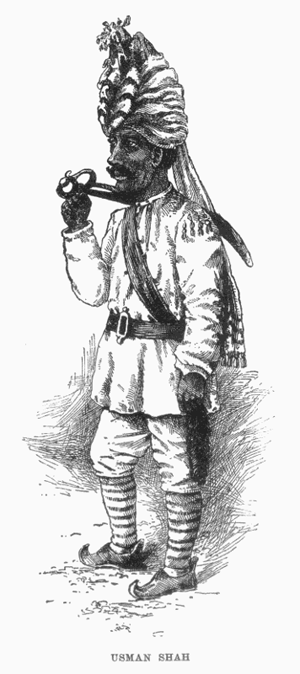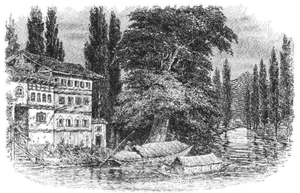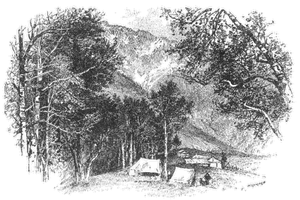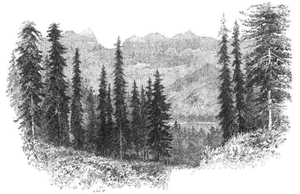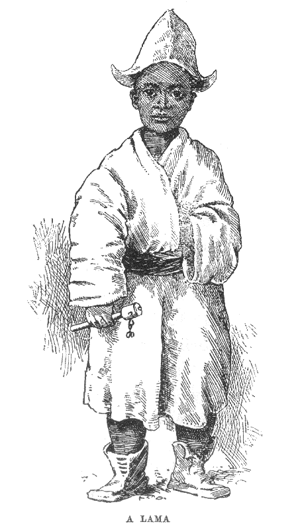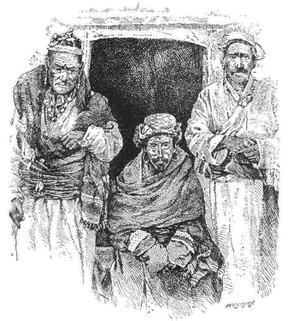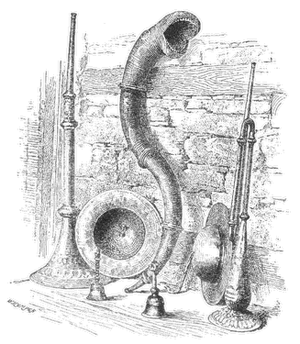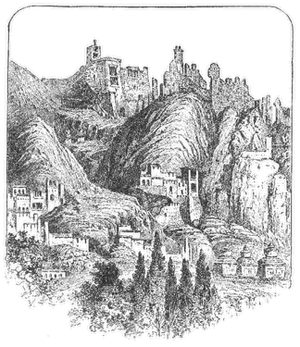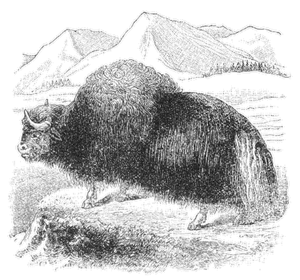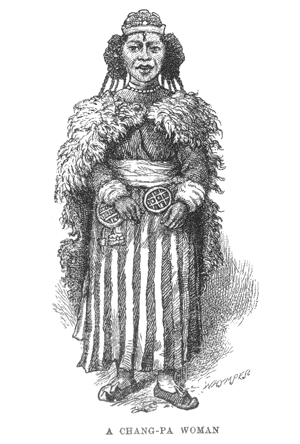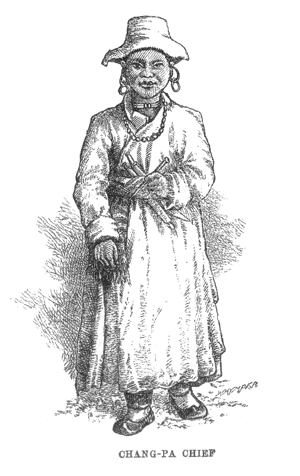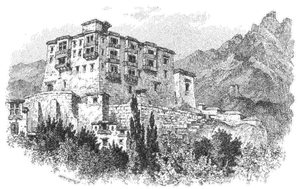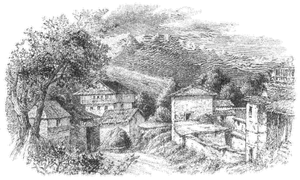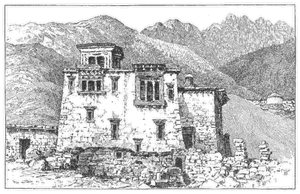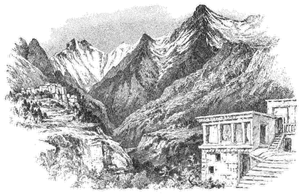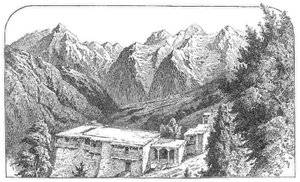CHAPTER II: SHERGOL AND LEHThe chaos of rocks and sand, walled in by vermilion and orange mountains, on which the village of Shergol stands, offered no facilities for camping; but somehow the men managed to pitch my tent on a steep slope, where I had to place my trestle bed astride an irrigation channel, down which the water bubbled noisily, on its way to keep alive some miserable patches of barley. At Shergol and elsewhere fodder is so scarce that the grain is not cut, but pulled up by the roots.
The intensely human interest of the journey began at that point. Not greater is the contrast between the grassy slopes and deodar-clothed mountains of Kashmir and the flaming aridity of Lesser Tibet, than between the tall, dark, handsome natives of the one, with their statuesque and shrinking women, and the ugly, short, squat, yellow-skinned, flat-nosed, oblique-eyed, uncouth-looking people of the other. The Kashmiris are false, cringing, and suspicious; the Tibetans truthful, independent, and friendly, one of the pleasantest of peoples. I 'took' to them at once at Shergol, and terribly faulty though their morals are in some respects, I found no reason to change my good opinion of them in the succeeding four months.
The headman or go-pa came to see me, introduced me to the objects of interest, which are a gonpo, or monastery, built into the rock, with a brightly coloured front, and three chod-tens, or relic-holders, painted blue, red, and yellow, and daubed with coarse arabesques and representations of deities, one having a striking resemblance to Mr. Gladstone. The houses are of mud, with flat roofs; but, being summer, many of them were roofless, the poplar rods which support the mud having been used for fuel. Conical stacks of the dried excreta of animals, the chief fuel of the country, adorned the roofs, but the general aspect was ruinous and poor. The people all invited me into their dark and dirty rooms, inhabited also by goats, offered tea and cheese, and felt my clothes. They looked the wildest of savages, but they are not. No house was so poor as not to have its 'family altar,' its shelf of wooden gods, and table of offerings. A religious atmosphere pervades Tibet, and gives it a singular sense of novelty. Not only were there chod-tens and a gonpo in this poor place, and family altars, but prayer-wheels, i.e. wooden cylinders filled with rolls of paper inscribed with prayers, revolving on sticks, to be turned by passers-by, inscribed cotton bannerets on poles planted in cairns, and on the roofs long sticks, to which strips of cotton bearing the universal prayer, Aum mani padne hun (O jewel of the lotus-flower), are attached. As these wave in the wind the occupants of the house gain the merit of repeating this sentence.
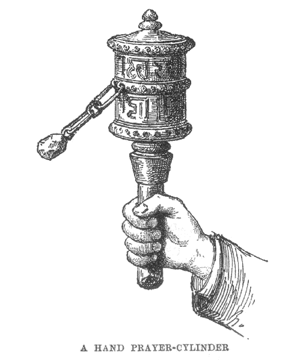 A HAND PRAYER-CYLINDER
A HAND PRAYER-CYLINDERThe remaining marches to Leh, the capital of Lesser Tibet, were full of fascination and novelty. Everywhere the Tibetans were friendly and cordial. In each village I was invited to the headman's house, and taken by him to visit the chief inhabitants; every traveller, lay and clerical, passed by with the cheerful salutation Tzu, asked me where I came from and whither I was going, wished me a good journey, admired Gyalpo, and when he scaled rock ladders and scrambled gamely through difficult torrents, cheered him like Englishmen, the general jollity and cordiality of manners contrasting cheerily with the chilling aloofness of Moslems.
The irredeemable ugliness of the Tibetans produced a deeper impression daily. It is grotesque, and is heightened, not modified, by their costume and ornament. They have high cheekbones, broad flat noses without visible bridges, small, dark, oblique eyes, with heavy lids and imperceptible eyebrows, wide mouths, full lips, thick, big, projecting ears, deformed by great hoops, straight black hair nearly as coarse as horsehair, and short, square, ungainly figures. The faces of the men are smooth. The women seldom exceed five feet in height, and a man is tall at five feet four.
The male costume is a long, loose, woollen coat with a girdle, trousers, under-garments, woollen leggings, and a cap with a turned-up point over each ear. The girdle is the depository of many things dear to a Tibetan—his purse, rude knife, heavy tinder-box, tobacco pouch, pipe, distaff, and sundry charms and amulets. In the capacious breast of his coat he carries wool for spinning—for he spins as he walks—balls of cold barley dough, and much besides. He wears his hair in a pigtail. The women wear short, big-sleeved jackets, shortish, full-plaited skirts, tight trousers a yard too long, the superfluous length forming folds above the ankle, a sheepskin with the fur outside hangs over the back, and on gala occasions a sort of drapery is worn over the usual dress. Felt or straw shoes and many heavy ornaments are worn by both sexes. Great ears of brocade, lined and edged with fur and attached to the hair, are worn by the women. Their hair is dressed once a month in many much-greased plaits, fastened together at the back by a long tassel. The head-dress is a strip of cloth or leather, sewn over with large turquoises, carbuncles, and silver ornaments. This hangs in a point over the brow, broadens over the top of the head, and tapers as it reaches the waist behind. The ambition of every Tibetan girl is centred in this singular headgear. Hoops in the ears, necklaces, amulets, clasps, bangles of brass or silver, and various implements stuck in the girdle and depending from it, complete a costume pre-eminent in ugliness. The Tibetans are dirty. They wash once a year, and, except for festivals, seldom change their clothes till they begin to drop off. They are healthy and hardy, even the women can carry weights of sixty pounds over the passes; they attain extreme old age; their voices are harsh and loud, and their laughter is noisy and hearty.
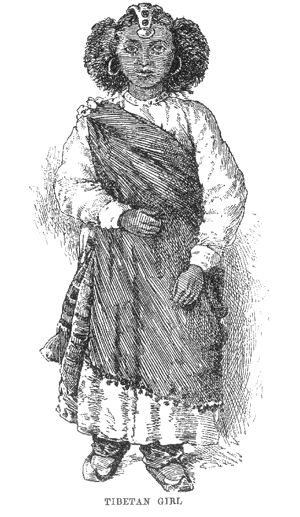 TIBETAN GIRL
TIBETAN GIRLAfter leaving Shergol the signs of Buddhism were universal and imposing, and the same may be said of the whole of the inhabited part of Lesser Tibet. Colossal figures of Shakya Thubba (Buddha) are carved on faces of rock, or in wood, stone, or gilded copper sit on lotus thrones in endless calm near villages of votaries. Chod-tens from twenty to a hundred feet in height, dedicated to 'holy' men, are scattered over elevated ground, or in imposing avenues line the approaches to hamlets and gonpos. There are also countless manis, dykes of stone from six to sixteen feet in width and from twenty feet to a fourth of a mile in length, roofed with flattish stones, inscribed by the lamas (monks) with the phrase Aum, &c., and purchased and deposited by those who wish to obtain any special benefit from the gods, such as a safe journey. Then there are prayer-mills, sometimes 150 in a row, which revolve easily by being brushed by the hand of the passer-by, larger prayer-cylinders which are turned by pulling ropes, and others larger still by water-power. The finest of the latter was in a temple overarching a perennial torrent, and was said to contain 20,000 repetitions of the mystic phrase, the fee to the worshipper for each revolution of the cylinder being from 1d. to 1s. 4d., according to his means or urgency.
The glory and pride of Ladak and Nubra are the gonpos, of which the illustrations give a slight idea. Their picturesqueness is absolutely enchanting. They are vast irregular piles of fantastic buildings, almost invariably crowning lofty isolated rocks or mountain spurs, reached by steep, rude rock staircases, chod-tens below and battlemented towers above, with temples, domes, bridges over chasms, spires, and scaffolded projections gleaming with gold, looking, as at Lamayuru, the outgrowth of the rock itself. The outer walls are usually whitewashed, and red, yellow, and brown wooden buildings, broad bands of red and blue on the whitewash, tridents, prayer-mills, yaks' tails, and flags on poles give colour and movement, while the jangle of cymbals, the ringing of bells, the incessant beating of big drums and gongs, and the braying at intervals of six-foot silver horns, attest the ritualistic activities of the communities within. The gonpos contain from two up to three hundred lamas. These are not cloistered, and their duties take them freely among the people, with whom they are closely linked, a younger son in every family being a monk. Every act in trade, agriculture, and social life needs the sanction of sacerdotalism, whatever exists of wealth is in the gonpos, which also have a monopoly of learning, and 11,000 monks, linked with the people, yet ruling all affairs of life and death and beyond death, are connected closely by education, tradition, and authority with Lhassa.
Passing along faces of precipices and over waterless plateaux of blazing red gravel—'waste places,' truly—the journey was cheered by the meeting of red and yellow lamas in companies, each lama twirling his prayer-cylinder, abbots, and skushoks (the latter believed to be incarnations of Buddha) with many retainers, or gay groups of priestly students, intoning in harsh and high-pitched monotones, Aum mani padne hun. And so past fascinating monastic buildings, through crystal torrents rushing over red rock, through flaming ravines, on rock ledges by scaffolded paths, camping in the afternoons near friendly villages on oases of irrigated alluvium, and down the Wanla water by the steepest and narrowest cleft ever used for traffic, I reached the Indus, crossed it by a wooden bridge where its broad, fierce current is narrowed by rocks to a width of sixty-five feet, and entered Ladak proper. A picturesque fort guards the bridge, and there travellers inscribe their names and are reported to Leh. I camped at Khalsi, a mile higher, but returned to the bridge in the evening to sketch, if I could, the grim nudity and repulsive horror of the surrounding mountains, attended only by Usman Shah. A few months earlier, this ruffian was sent down from Leh with six other soldiers and an officer to guard the fort, where they became the terror of all who crossed the bridge by their outrageous levies of blackmail. My swashbuckler quarrelled with the officer over a disreputable affair, and one night stabbed him mortally, induced his six comrades to plunge their knives into the body, sewed it up in a blanket, and threw it into the Indus, which disgorged it a little lower down. The men were all arrested and marched to Srinagar, where Usman turned 'king's evidence.'
The remaining marches were alongside of the tremendous granite ranges which divide the Indus from its great tributary, the Shayok. Colossal scenery, desperate aridity, tremendous solar heat, and an atmosphere highly rarefied and of nearly intolerable dryness, were the chief characteristics. At these Tibetan altitudes, where the valleys exceed 11,000 feet, the sun's rays are even more powerful than on the 'burning plains of India.' The day wind, rising at 9 a.m., and only falling near sunset, blows with great heat and force. The solar heat at noon was from 120° to 130°, and at night the mercury frequently fell below the freezing point. I did not suffer from the climate, but in the case of most Europeans the air passages become irritated, the skin cracks, and after a time the action of the heart is affected. The hair when released stands out from the head, leather shrivels and splits, horn combs break to pieces, food dries up, rapid evaporation renders water-colour sketching nearly impossible, and tea made with water from fifteen to twenty below the boiling-point of 212 degrees, is flavourless and flat.
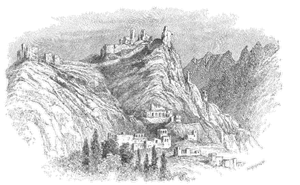 GONPO OF SPITAK
GONPO OF SPITAKAfter a delightful journey of twenty-five days I camped at Spitak, among the chod-tens and manis which cluster round the base of a lofty and isolated rock, crowned with one of the most striking monasteries in Ladak, and very early the next morning, under a sun of terrific fierceness, rode up a five-mile slope of blazing gravel to the goal of my long march. Even at a short distance off, the Tibetan capital can scarcely be distinguished from the bare, ribbed, scored, jagged, vermilion and rose-red mountains which nearly surround it, were it not for the palace of the former kings or Gyalpos of Ladak, a huge building attaining ten storeys in height, with massive walls sloping inwards, while long balconies and galleries, carved projections of brown wood, and prominent windows, give it a singular picturesqueness. It can be seen for many miles, and dwarfs the little Central Asian town which clusters round its base.
Long lines of chod-tens and manis mark the approach to Leh. Then come barley fields and poplar and willow plantations, bright streams are crossed, and a small gateway, within which is a colony of very poor Baltis, gives access to the city. In consequence of 'the vigilance of the guard at the bridge of Khalsi,' I was expected, and was met at the gate by the wazir's jemadar, or head of police, in artistic attire, with spahis in apricot turbans, violet chogas, and green leggings, who cleared the way with spears, Gyalpo frolicking as merrily and as ready to bite, and the Afghan striding in front as firmly, as though they had not marched for twenty-five days through the rugged passes of the Himalayas. In such wise I was escorted to a shady bungalow of three rooms, in the grounds of H. B. M.'s Joint Commissioner, who lives at Leh during the four months of the 'caravan season,' to assist in regulating the traffic and to guard the interests of the numerous British subjects who pass through Leh with merchandise. For their benefit also, the Indian Government aids in the support of a small hospital, open, however, to all, which, with a largely attended dispensary, is under the charge of a Moravian medical missionary.
Just outside the Commissioner's grounds are two very humble whitewashed dwellings, with small gardens brilliant with European flowers; and in these the two Moravian missionaries, the only permanent European residents in Leh, were living, Mr. Redslob and Dr. Karl Marx, with their wives. Dr. Marx was at his gate to welcome me.
To these two men, especially the former, I owe a debt of gratitude which in no shape, not even by the hearty acknowledgment of it, can ever be repaid, for they died within a few days of each other, of an epidemic, last year, Dr. Marx and a new-born son being buried in one grave. For twenty-five years Mr. Redslob, a man of noble physique and intellect, a scholar and linguist, an expert botanist and an admirable artist, devoted himself to the welfare of the Tibetans, and though his great aim was to Christianize them, he gained their confidence so thoroughly by his virtues, kindness, profound Tibetan scholarship, and manliness, that he was loved and welcomed everywhere, and is now mourned for as the best and truest friend the people ever had.
I had scarcely finished breakfast when he called; a man of great height and strong voice, with a cheery manner, a face beaming with kindness, and speaking excellent English. Leh was the goal of my journey, but Mr. Redslob came with a proposal to escort me over the great passes to the northward for a three weeks' journey to Nubra, a district formed of the combined valleys of the Shayok and Nubra rivers, tributaries of the Indus, and abounding in interest. Of course I at once accepted an offer so full of advantages, and the performance was better even than the promise.
Two days were occupied in making preparations, but afterwards I spent a fortnight in my tent at Leh, a city by no means to be passed over without remark, for, though it and the region of which it is the capital are very remote from the thoughts of most readers, it is one of the centres of Central Asian commerce. There all traders from India, Kashmir, and Afghanistan must halt for animals and supplies on their way to Yarkand and Khotan, and there also merchants from the mysterious city of Lhassa do a great business in brick tea and in Lhassa wares, chiefly ecclesiastical.
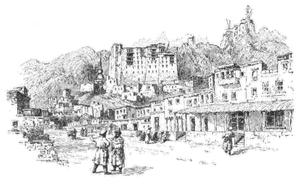 LEH
LEHThe situation of Leh is a grand one, the great Kailas range, with its glaciers and snowfields, rising just behind it to the north, its passes alone reaching an altitude of nearly 18,000 feet; while to the south, across a gravelly descent and the Indus Valley, rise great red ranges dominated by snow-peaks exceeding 21,000 feet in altitude. The centre of Leh is a wide bazaar, where much polo is played in the afternoons; and above this the irregular, flat-roofed, many-balconied houses of the town cluster round the palace and a gigantic chod-ten alongside it. The rugged crest of the rock on a spur of which the palace stands is crowned by the fantastic buildings of an ancient gonpo. Beyond the crops and plantations which surround the town lies a flaming desert of gravel or rock. The architectural features of Leh, except of the palace, are mean. A new mosque glaring with vulgar colour, a treasury and court of justice, the wazir's bungalow, a Moslem cemetery, and Buddhist cremation grounds, in which each family has its separate burning place, are all that is noteworthy. The narrow alleys, which would be abominably dirty if dirt were possible in a climate of such intense dryness, house a very mixed population, in which the Moslem element is always increasing, partly owing to the renewal of that proselytising energy which is making itself felt throughout Asia, and partly to the marriages of Moslem traders with Ladaki women, who embrace the faith of their husbands and bring up their families in the same.
On my arrival few of the shops in the great place, or bazaar, were open, and there was no business; but a few weeks later the little desert capital nearly doubled its population, and during August the din and stir of trade and amusements ceased not by day or night, and the shifting scenes were as gay in colouring and as full of variety as could be desired.
Great caravans en route for Khotan, Yarkand, and even Chinese Tibet arrived daily from Kashmir, the Panjāb, and Afghanistan, and stacked their bales of goods in the place; the Lhassa traders opened shops in which the specialties were brick tea and instruments of worship; merchants from Amritsar, Cabul, Bokhara, and Yarkand, stately in costume and gait, thronged the bazaar and opened bales of costly goods in tantalising fashion; mules, asses, horses, and yaks kicked, squealed, and bellowed; the dissonance of bargaining tongues rose high; there were mendicant monks, Indian fakirs, Moslem dervishes, Mecca pilgrims, itinerant musicians, and Buddhist ballad howlers; bold-faced women with creels on their backs brought in lucerne; Ladakis, Baltis, and Lahulis tended the beasts, and the wazir's jemadar and gay spahis moved about among the throngs. In the midst of this picturesque confusion, the short, square-built, Lhassa traders, who face the blazing sun in heavy winter clothing, exchange their expensive tea for Nubra and Baltistan dried apricots, Kashmir saffron, and rich stuffs from India; and merchants from Yarkand on big Turkestan horses offer hemp, which is smoked as opium, and Russian trifles and dress goods, under cloudless skies. With the huge Kailas range as a background, this great rendezvous of Central Asian traffic has a great fascination, even though moral shadows of the darkest kind abound.
On the second morning, while I was taking the sketch of Usman Shah which appears as the frontispiece, he was recognised both by the Joint Commissioner and the chief of police as a mutineer and murderer, and was marched out of Leh. I was asked to look over my baggage, but did not. I had trusted him, he had been faithful in his way, and later I found that nothing was missing. He was a brutal ruffian, one of a band of irregulars sent by the Maharajah of Kashmir to garrison the fort at Leh. From it they used to descend on the town, plunder the bazaar, insult the women, take all they wanted without payment, and when one of their number was being tried for some offence, they dragged the judge out of court and beat him! After holding Leh in terror for some time the British Commissioner obtained their removal. It was, however, at the fort at the Indus bridge, as related before, that the crime of murder was committed. Still there was something almost grand in the defiant attitude of the fantastic swashbuckler, as, standing outside the bungalow, he faced the British Commissioner, to him the embodiment of all earthly power, and the chief of police, and defied them. Not an inch would he stir till the wazir gave him a coolie to carry his baggage. He had been acquitted of the murder, he said, 'and though I killed the man, it was according to the custom of my country—he gave me an insult which could only be wiped out in blood!' The guard dared not touch him, and he went to the wazir, demanded a coolie, and got one!
Our party left Leh early on a glorious morning, travelling light, Mr. Redslob, a very learned Lhassa monk, named Gergan, Mr. R.'s servant, my three, and four baggage horses, with two drivers engaged for the journey. The great Kailas range was to be crossed, and the first day's march up long, barren, stony valleys, without interest, took us to a piece of level ground, with a small semi-subterranean refuge on which there was barely room for two tents, at the altitude of the summit of Mont Blanc. For two hours before we reached it the men and animals showed great distress. Gyalpo stopped every few yards, gasping, with blood trickling from his nostrils, and turned his head so as to look at me, with the question in his eyes, What does this mean? Hassan Khan was reeling from vertigo, but would not give in; the seis, a creature without pluck, was carried in a blanket slung on my tent poles, and even the Tibetans suffered. I felt no inconvenience, but as I unsaddled Gyalpo I was glad that there was no more work to do! This 'mountain-sickness,' called by the natives ladug, or 'pass-poison,' is supposed by them to be the result of the odour or pollen of certain plants which grow on the passes. Horses and mules are unable to carry their loads, and men suffer from vertigo, vomiting, violent headache and bleeding from the nose, mouth, and ears, as well as prostration of strength, sometimes complete, and occasionally ending fatally.
After a bitterly cold night I was awakened at dawn by novel sounds, gruntings, and low, resonant bellowing round my tent, and the grey light revealed several yaks (the Bos grunniens, the Tibetan ox), the pride of the Tibetan highlands. This magnificent animal, though not exceeding an English shorthorn cow in height, looks gigantic, with his thick curved horns, his wild eyes glaring from under a mass of curls, his long thick hair hanging to his fetlocks, and his huge bushy tail. He is usually black or tawny, but the tail is often white, and is the length of his long hair. The nose is fine and has a look of breeding as well as power. He only flourishes at altitudes exceeding 12,000 feet. Even after generations of semi-domestication he is very wild, and can only be managed by being led with a rope attached to a ring in the nostrils. He disdains the plough, but condescends to carry burdens, and numbers of the Ladak and Nubra people get their living by carrying goods for the traders on his broad back over the great passes. His legs are very short, and he has a sensible way of measuring distance with his eyes and planting his feet, which enables him to carry loads where it might be supposed that only a goat could climb. He picks up a living anyhow, in that respect resembling the camel.
He has an uncertain temper, and is not favourably disposed towards his rider. Indeed, my experience was that just as one was about to mount him he usually made a lunge at one with his horns. Some of my yak steeds shied, plunged, kicked, executed fantastic movements on the ledges of precipices, knocked down their leaders, bellowed defiance, and rushed madly down mountain sides, leaping from boulder to boulder, till they landed me among their fellows. The rush of a herd of bellowing yaks at a wild gallop, waving their huge tails, is a grand sight.
My first yak was fairly quiet, and looked a noble steed, with my Mexican saddle and gay blanket among rather than upon his thick black locks. His back seemed as broad as that of an elephant, and with his slow, sure, resolute step, he was like a mountain in motion. We took five hours for the ascent of the Digar Pass, our loads and some of us on yaks, some walking, and those who suffered most from the 'pass-poison' and could not sit on yaks were carried. A number of Tibetans went up with us. It was a new thing for a European lady to travel in Nubra, and they took a friendly interest in my getting through all right. The dreary stretches of the ascent, though at first white with edelweiss, of which the people make their tinder, are surmounted for the most part by steep, short zigzags of broken stone. The heavens were dark with snow-showers, the wind was high and the cold severe, and gasping horses, and men prostrate on their faces unable to move, suggested a considerable amount of suffering; but all safely reached the summit, 17,930 feet, where in a snowstorm the guides huzzaed, praised their gods, and tucked rag streamers into a cairn. The loads were replaced on the horses, and over wastes of ice, across snowfields margined by broad splashes of rose-red primulas, down desert valleys and along irrigated hillsides, we descended 3,700 feet to the village of Digar in Nubra, where under a cloudless sky the mercury stood at 90°!
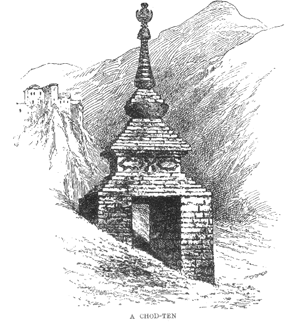 A CHOD-TEN
A CHOD-TENUpper and Lower Nubra consist of the valleys of the Nubra and Shayok rivers. These are deep, fierce, variable streams, which have buried the lower levels under great stretches of shingle, patched with jungles of hippophaë and tamarisk, affording cover for innumerable wolves. Great lateral torrents descend to these rivers, and on alluvial ridges formed at the junctions are the villages with their pleasant surroundings of barley, lucerne, wheat, with poplar and fruit trees, and their picturesque gonpos crowning spurs of rock above them. The first view of Nubra is not beautiful. Yellow, absolutely barren mountains, cleft by yellow gorges, and apparently formed of yellow gravel, the huge rifts in their sides alone showing their substructure of rock, look as if they had never been finished, or had been finished so long that they had returned to chaos. These hem in a valley of grey sand and shingle, threaded by a greyish stream. From the second view point mountains are seen descending on a pleasanter part of the Shayok valley in grey, yellow, or vermilion masses of naked rock, 7,000 and 8,000 feet in height, above which rise snow-capped peaks sending out fantastic spurs and buttresses, while the colossal walls of rock are cleft by rifts as colossal. The central ridge between the Nubra and Upper Shayok valleys is 20,000 feet in altitude, and on this are superimposed five peaks of rock, ascertained by survey to be from 24,000 to 25,000 feet in height, while at one point the eye takes in a nearly vertical height of 14,000 feet from the level of the Shayok River! The Shayok and Nubra valleys are only five and four miles in width respectively at their widest parts. The early winter traffic chiefly follows along river beds, then nearly dry, while summer caravans have to labour along difficult tracks at great heights, where mud and snow avalanches are common, to climb dangerous rock ladders, and to cross glaciers and the risky fords of the Shayok. Nubra is similar in character to Ladak, but it is hotter and more fertile, the mountains are loftier, the gonpos are more numerous, and the people are simpler, more religious, and more purely Tibetan. Mr. Redslob loved Nubra, and as love begets love he received a hearty welcome at Digar and everywhere else.
The descent to the Shayok River gave us a most severe day of twelve hours. The river had covered the usual track, and we had to take to torrent beds and precipice ledges, I on one yak, and my tent on another. In years of travel I have never seen such difficulties. Eventually at dusk Mr. Redslob, Gergan, the servants, and I descended on a broad shingle bed by the rushing Shayok; but it was not till dawn on the following day that, by means of our two yaks and the muleteers, our baggage and food arrived, the baggage horses being brought down unloaded, with men holding the head and tail of each. Our saddle horses, which we led with us, were much cut by falls. Gyalpo fell fully twenty feet, and got his side laid open. The baggage horses, according to their owners, had all gone over one precipice, which delayed them five hours.
Below us lay two leaky scows, and eight men from Sati, on the other side of the Shayok, are pledged to the Government to ferry travellers; but no amount of shouting and yelling, or burning of brushwood, or even firing, brought them to the rescue, though their pleasant lights were only a mile off. Snow fell, the wind was strong and keen, and our tent-pegs were only kept down by heavy stones. Blankets in abundance were laid down, yet failed to soften the 'paving stones' on which I slept that night! We had tea and rice, but our men, whose baggage was astray on the mountains, were without food for twenty-two hours, positively refusing to eat our food or cook fresh rice in our cooking pots! To such an extent has Hindu caste-feeling infected Moslems! The disasters of that day's march, besides various breakages, were, two servants helpless from 'pass-poison' and bruises; a Ladaki, who had rolled over a precipice, with a broken arm, and Gergan bleeding from an ugly scalp wound, also from a fall.
By eight o'clock the next morning the sun was high and brilliant, the snows of the ravines under its fierce heat were melting fast, and the river, roaring hoarsely, was a mad rush of grey rapids and grey foam; but three weeks later in the season, lower down, its many branches are only two feet deep. This Shayok, which cannot in any way be circumvented, is the great obstacle on this Yarkand trade route. Travellers and their goods make the perilous passage in the scow, but their animals swim, and are often paralysed by the ice-cold water and drowned. My Moslem servants, white-lipped and trembling, committed themselves to Allah on the river bank, and the Buddhists worshipped their sleeve idols. The gopa, or headman of Sati, a splendid fellow, who accompanied us through Nubra, and eight wild-looking, half-naked satellites, were the Charons of that Styx. They poled and paddled with yells of excitement; the rapids seized the scow, and carried her broadside down into hissing and raging surges; then there was a plash, a leap of maddened water half filling the boat, a struggle, a whirl, violent efforts, and a united yell, and far down the torrent we were in smooth water on the opposite shore. The ferrymen recrossed, pulled our saddle horses by ropes into the river, the gopa held them; again the scow and her frantic crew, poling, paddling, and yelling, were hurried broadside down, and as they swept past there were glimpses above and among the foam-crested surges of the wild-looking heads and drifting forelocks of two grey horses swimming desperately for their lives,—a splendid sight. They landed safely, but of the baggage animals one was sucked under the boat and drowned, and as the others refused to face the rapids, we had to obtain other transport. A few days later the scow, which was brought up in pieces from Kashmir on coolies' backs at a cost of four hundred rupees, was dashed to pieces!
A halt for Sunday in an apricot grove in the pleasant village of Sati refreshed us all for the long marches which followed, by which we crossed the Sasir Pass, full of difficulties from snow and glaciers, which extend for many miles, to the Dipsang Plain, the bleakest and dreariest of Central Asian wastes, from which the gentle ascent of the Karakorum Pass rises, and returned, varying our route slightly, to the pleasant villages of the Nubra valley. Everywhere Mr. Redslob's Tibetan scholarship, his old-world courtesy, his kindness and adaptability, and his medical skill, ensured us a welcome the heartiness of which I cannot describe. The headmen and elders of the villages came to meet us when we arrived, and escorted us when we left; the monasteries and houses with the best they contained were thrown open to us; the men sat round our camp-fires at night, telling stories and local gossip, and asking questions, everything being translated to me by my kind guide, and so we actually lived 'among the Tibetans.'
